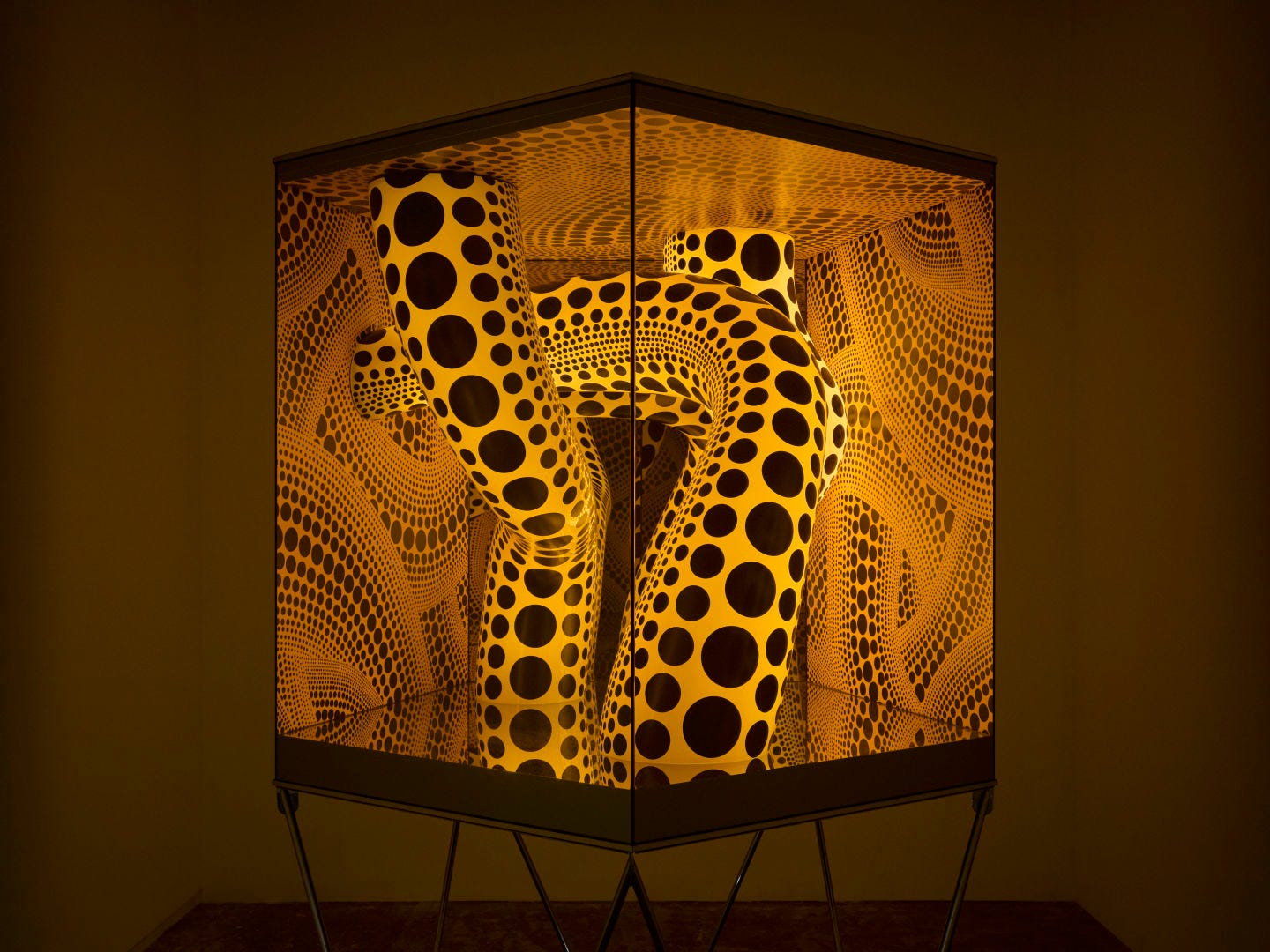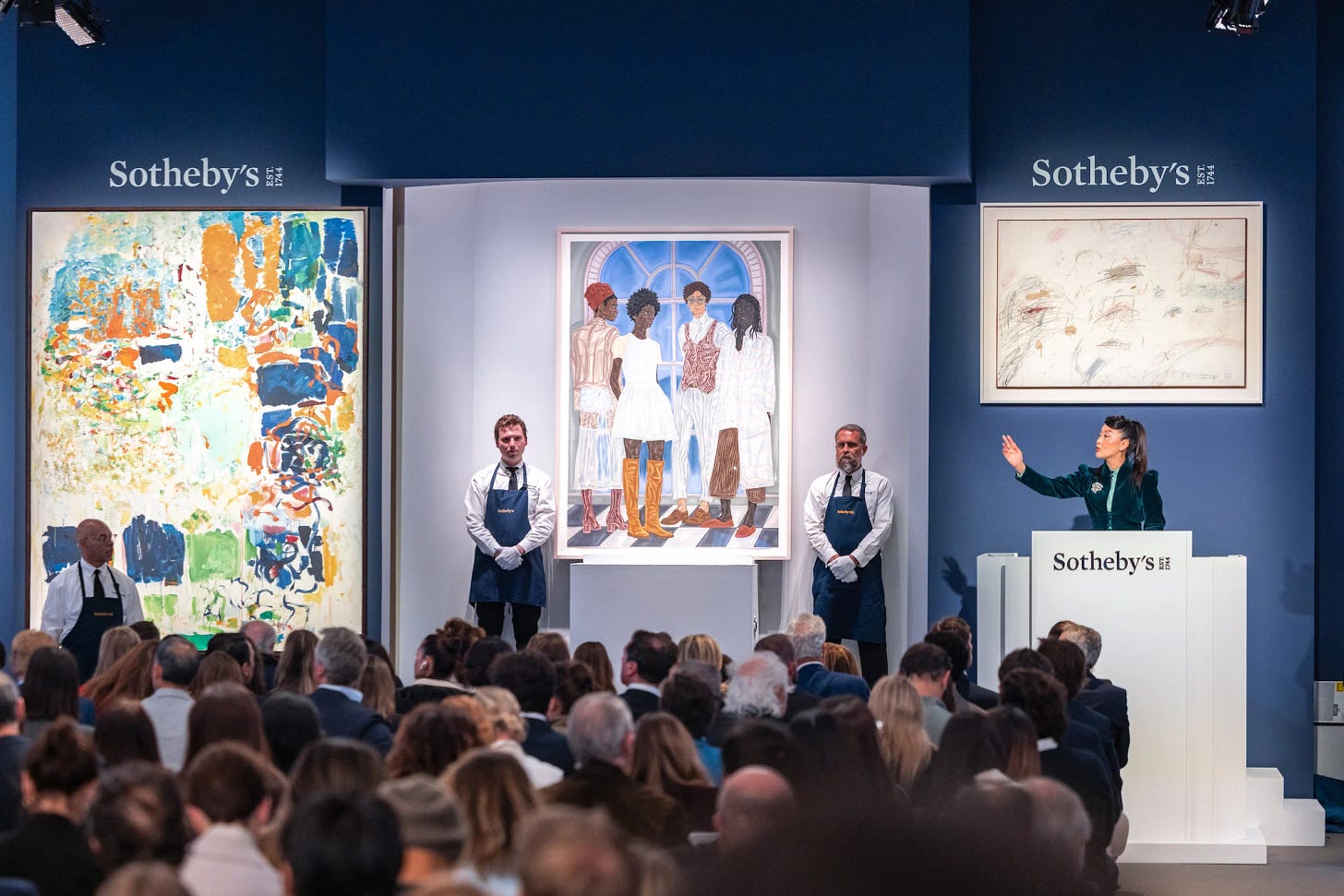The Research Corner #5 - 7.9.24
Exploring the intersection of Art, Finance, and Artificial Intelligence.

Coming off a second consecutive lackluster summer auction season, Sotheby’s is continuing its rollout of policy and process changes with the announcement of “Sotheby’s Sealed” auctions. Earlier this May, the auction house unveiled a revised fee structure, eliciting mixed responses from stakeholders.
While the sealed bid format is not an entirely new concept for Sotheby’s, it marks a significant evolution in their approach. Since at least 2022, Sotheby’s has held sealed auctions for luxury goods such as rare cars, watches, wines, and spirits. For instance, Sotheby’s Sealed auctioned an ultra-rare spec McLaren F1, estimated at over $20MM, on May 13th. The company is now looking to incorporate this bidding program into its fine art auctions, debuting with a one-lot auction featuring a classic infinity mirror piece by Yayoi Kusama.
So what is Sotheby’s Sealed? According to their website, this program is designed to facilitate the sale of the “finest items from the world’s top designers, brands, and manufacturers.” Unlike traditional auctions at Sotheby’s, these sealed auctions introduce certain built-in mechanisms that create a uniquely opaque and, arguably, dubious bidding experience. Bidders participate without any knowledge of bids submitted by others, rendering it challenging to gauge real-time valuations for lots offered through sealed auctions.
Upon submitting a bid, participants are only informed of their rank relative to other bidders, with no specific figures disclosed throughout the auction. Even the top bidder is only notified of their status as the “high bid”, without any insight into the margin by which they lead. For example, a leading bid of $10MM may significantly surpass the second-highest bid of $2MM, yet this information remains undisclosed to the top bidder. This all seems fine in a world where this sealed bid program is used sparingly and for the most exclusive of lots. However, their rollout seems to suggest otherwise.
Interestingly, Sotheby’s Sealed’s commitment to not disclosing realized hammer prices, lot statuses, and other relevant accompanying attributes for auctioned lots may be most contentious and egregious to the art market. This lack of transparency signals the auction house’s continued negligence toward any method of standardized valuation by distorting historical pricing models.
This shift poses a real threat to consumer and market-driven valuations at auction. While Sotheby’s Sealed has traditionally featured elite lots, it seems the auction house is pivoting its strategy for fine art offerings.
Let’s look at Sotheby’s Sealed’s initial foray into fine art. Beginning with a classic infinity work by Kusama is an excellent (and pragmatic) way to test the waters and gauge market response while ensuring demand. However, Phantom Polka Dots of Fate by Kusama, estimated between $1.29MM to $1.93MM, doesn’t seem to match the caliber of uber-elite collectibles offered previously associated with Sotheby’s Sealed. This discrepancy suggests that Sotheby’s may be experimenting with their sealed auction process with more standard lots rather than indicating a deficiency in available quality works.
This transition, though it may appear unfounded at first glance, could offer Sotheby’s several strategic advantages. Let’s start with the obvious: Sotheby’s needs to turn its auction results around. For example, the recent Sotheby’s Contemporary Evening Auction reported a hammer price (excluding buyer’s fees) of $201.1MM, falling short of its $217.6MM low estimate by more than $16MM. Despite a respectable sell-through rate of 91.4%, demand is clearly not the core issue.
The market is still stabilizing after expansive growth in 2021, and many works remain significantly overpriced, contributing to market volatility. I find this instability is likely a consequence of a lack of clear direction for pricing. Rather than addressing the need for transparency and valuation guidance, there seems to be a sustained effort by auction houses to return to previous market highs by manipulating consumer behavior.
It is worth noting they are not alone in this challenge—Christie’s and Phillips find themselves facing similar pressures—but Sotheby’s appears most willing of the houses to change the auction environment to their advantage. We see this evidenced by their willingness to implement new policy and process changes this summer season.
Sotheby’s stands to benefit from withholding auction results, as its sealed bid strategy limits the data available to consumers. On a micro level, bidders lack information on specific bid rankings within each auction, and on a macro level, there is less published data for market comparables. This leads to less informed bidding, increased reliance on Sotheby’s in-house advisors, and potentially higher realized prices due to strategic information asymmetry. Further, this could create a market environment where Sotheby’s controls more of the narrative and perceived value, reducing the leverage of external market factors.
Sotheby’s Sealed’s first fine art auction concluded just two weeks ago—unsurprisingly, results were not published. It remains unclear whether Sotheby’s will incorporate these sealed auctions more frequently compared to their use for cars and other luxury item counterparts, but this is certainly something to continue monitoring. I do see this model being particularly useful for auctions with less clarity as to pre-auction estimates, such as works estimated “in excess of $30MM.” Traditionally, these high-value lots have been crucial in Evening Auctions, contributing significantly to the total sales figures.
However, I don’t see Sotheby’s breaking these marquee lots off and sidelining them to Sotheby’s Sealed, as they are crucial to the overall sales narrative of their respective auctions. In any case, the broader application of this model appears inherently detrimental to all market participants. This approach could significantly undermine market transparency and trust, essential for a healthy, functioning market environment. I sincerely hope Sotheby’s does not move to integrate Sotheby’s Sealed into their day-to-day operations.
Are you intrigued by the evolving strategies auction houses use to market high-value artworks and how data analytics is reshaping art investments? Whether you're an experienced collector, a financial analyst, or simply interested in the dynamics of art investment, your perspective is crucial to our discussion. Share your thoughts and questions in the comments below, or contact us directly at RoverResearch@yahoo.com. We value your input and look forward to engaging with you!
Disclaimer: The content provided in this article is for informational purposes only and is not intended as financial, investment, tax, legal, or accounting advice. The information and opinions expressed herein are the author's own and do not constitute professional investment advice. Investment decisions should always be made based on an individual's specific financial needs, objectives, goals, time horizon, and risk tolerance. The author and publisher are not engaged in rendering professional services or advice, and the information provided should not be considered a substitute for professional advice. While the data and analysis used in this article are believed to be accurate, they have been provided by the author without warranty of any kind, express or implied. The author and publisher shall not be liable for any losses, damages, costs, or expenses (including direct, indirect, incidental, consequential, or punitive damages) arising out of or in connection with the access to, use of, reliance on, or inability to use any of the information or opinions expressed in this article. Readers are encouraged to consult with their own qualified financial advisor before making any investment decisions. Investments may lose value over time and loss principal is not insured.





